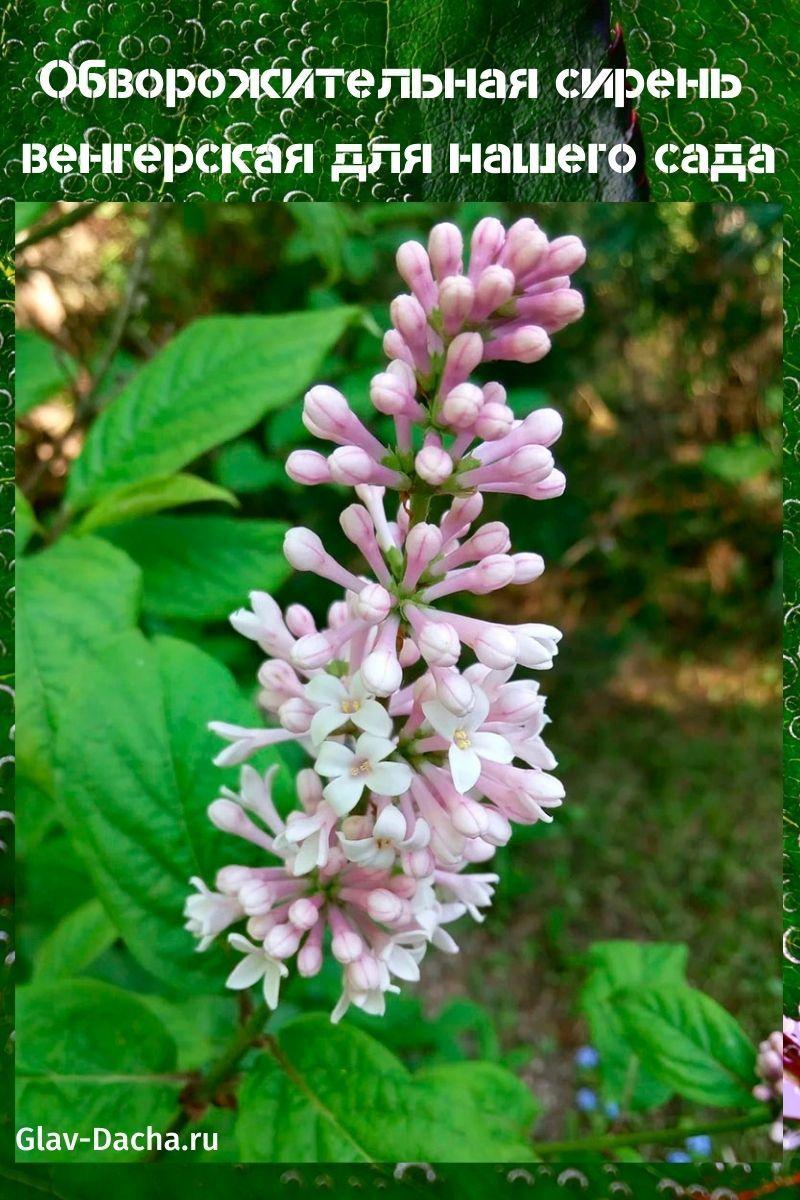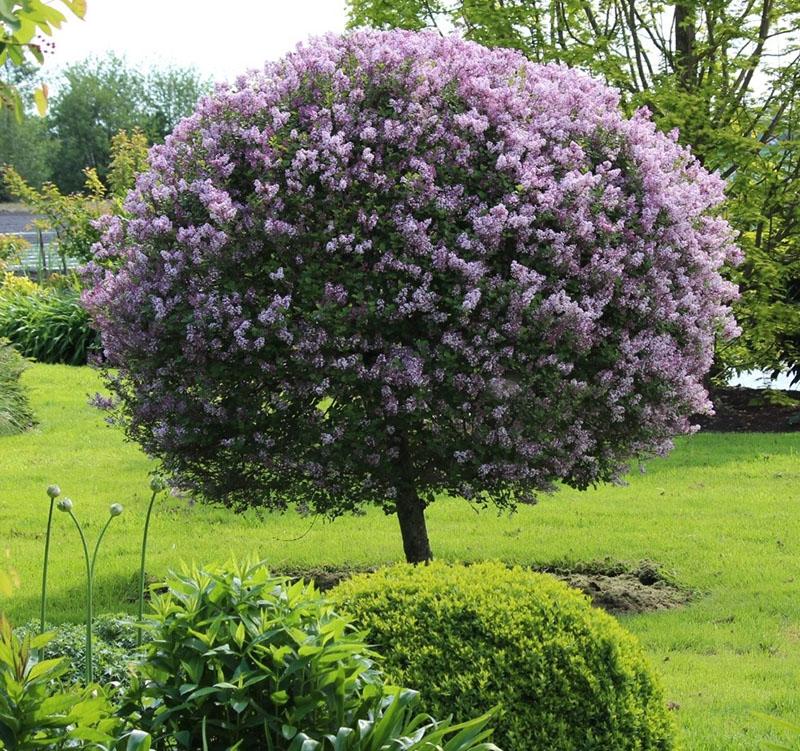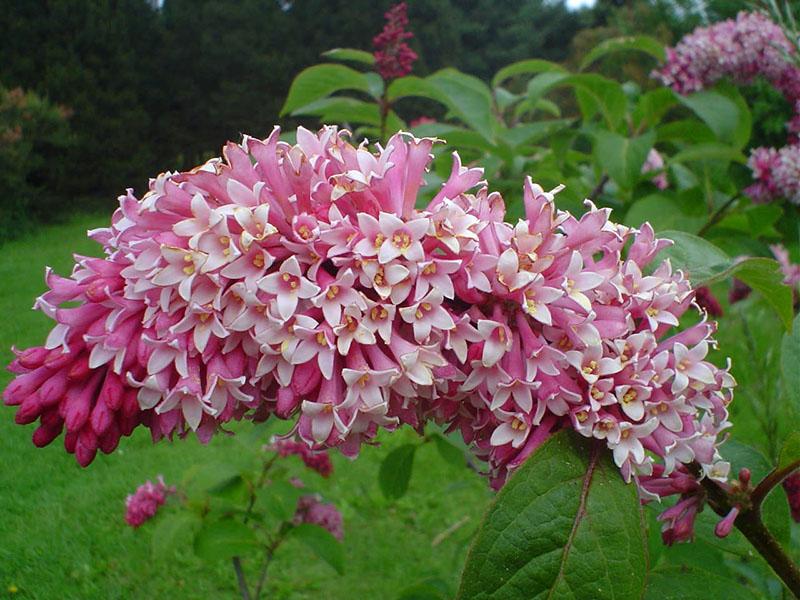Charming Hungarian lilac for our garden
 Flowering shrubs are an important element of the suburban area. Each of them is distinguished by its unique beauty, and the Hungarian lilac also smells good. The plant wonderfully takes root in both southern and cooler latitudes. It is actively used to create stylish landscapes in city parks and private houses. How did the Hungarian lilacs strike the flora admirers? Let's look at the shrub from the side.
Flowering shrubs are an important element of the suburban area. Each of them is distinguished by its unique beauty, and the Hungarian lilac also smells good. The plant wonderfully takes root in both southern and cooler latitudes. It is actively used to create stylish landscapes in city parks and private houses. How did the Hungarian lilacs strike the flora admirers? Let's look at the shrub from the side.
Bright bouquets with a heady aroma

 Let's start with a description of the Hungarian lilac, which fascinates us with its amazing appearance.
Let's start with a description of the Hungarian lilac, which fascinates us with its amazing appearance.
Biologists classify several forms of culture:
- Pale (pale lilac color of buds);

- Red-flowered (bright purple shade of petals);

- White-flowered (inflorescences are painted in snow-white color);

- Pink (bouquets with a pale pink tint).

The culture has a compact crown that resembles a large chicken egg. On average, its diameter reaches 4 m at the same height. It consists of many strong branches pointing towards the sky and in different directions.
 Leaf plates, up to 13 cm long, are elliptical. The ciliated edge is visible on the back side. They are painted deep green. With the arrival of autumn, the foliage gradually turns yellow and is carried away by the wind to the foot of the bush.
Leaf plates, up to 13 cm long, are elliptical. The ciliated edge is visible on the back side. They are painted deep green. With the arrival of autumn, the foliage gradually turns yellow and is carried away by the wind to the foot of the bush.
 The flowering culture begins about 10-15 days later than that of common lilac. She adequately takes over the baton and pleases the eye for another month. Among the lush greenery, loose pyramidal inflorescences up to 30 cm long are formed. Each of them consists of many tubular buds, painted in bright colors. During the period of lush flowering, there is a mesmerizing scent around the shrub, which attracts hundreds of insects ready to feast on sweet nectar. Then the territory of the garden turns into a cozy corner of bliss. But how do you grow a culture in your garden? Find out what the experts are saying.
The flowering culture begins about 10-15 days later than that of common lilac. She adequately takes over the baton and pleases the eye for another month. Among the lush greenery, loose pyramidal inflorescences up to 30 cm long are formed. Each of them consists of many tubular buds, painted in bright colors. During the period of lush flowering, there is a mesmerizing scent around the shrub, which attracts hundreds of insects ready to feast on sweet nectar. Then the territory of the garden turns into a cozy corner of bliss. But how do you grow a culture in your garden? Find out what the experts are saying.
The Hungarian lilac plant is considered a long-liver. It grows on one site for about 90 years.
Hungarian lilac: planting algorithm
 Gardeners use culture as a decorative ornament. It is planted near fences and gates. They make a hedge from the bushes.
Gardeners use culture as a decorative ornament. It is planted near fences and gates. They make a hedge from the bushes.
The plant looks great against the background:
- mixborders;
- alpine slides;
- ordinary flower fields;
- other shrubs.
 The optimal planting period for Hungarian lilacs is mid-July and late August. Before winter, it will take root, and in the spring there will already be the first growth. The procedure is performed in the evening or in cloudy weather.
The optimal planting period for Hungarian lilacs is mid-July and late August. Before winter, it will take root, and in the spring there will already be the first growth. The procedure is performed in the evening or in cloudy weather.
For a successful result, use high-quality seedlings that meet agronomic requirements:
- branched root system;
- crown with three buds;
- without mechanical damage.
Usually, long roots are carefully shortened, and dry or rotten ones are completely removed. The resulting specimens are ready for planting in the garden.
Saplings should have branched roots, 25 to 30 cm long.
Suitable place and soil
 Lilacs love the abundance of sunlight. Therefore, the seedling is best placed in an open area. However, there should be no drafts on it.Although the crop can handle cold winters with ease, gusty autumn or spring winds can harm it.
Lilacs love the abundance of sunlight. Therefore, the seedling is best placed in an open area. However, there should be no drafts on it.Although the crop can handle cold winters with ease, gusty autumn or spring winds can harm it.
The shrub takes root well in the shade of tall trees with a spreading and loose crown.
 It has been observed that Hungarian lilacs do not like swampy and clayey soils. The root system does not like excessive moisture, therefore it quickly rots. As a result, the young seedling dies. The plant prefers fertile soil with neutral acidity.
It has been observed that Hungarian lilacs do not like swampy and clayey soils. The root system does not like excessive moisture, therefore it quickly rots. As a result, the young seedling dies. The plant prefers fertile soil with neutral acidity.
If necessary, it is created artificially by adding the following components:
- humus;
- compost;
- ash;
- superphosphate.
The proportions are set depending on the acidity level of the soil. The main thing is to achieve a neutral environment. Next, they begin to prepare the pit.
Landing technology
 The first step is to pull out a suitable hole. If the land is sandy in the country, then its dimensions should be 90x90x90 cm. On fertile soil, you can make 45x45x45 cm. The walls of the pit are made of a sheer nature. The main thing is that the root system of the bush is successfully located in the hole.
The first step is to pull out a suitable hole. If the land is sandy in the country, then its dimensions should be 90x90x90 cm. On fertile soil, you can make 45x45x45 cm. The walls of the pit are made of a sheer nature. The main thing is that the root system of the bush is successfully located in the hole.
 The dug soil is thoroughly mixed with fertilizer. The seedling is placed in the center of the pit, carefully laying the roots. The voids are covered with the prepared substrate and lightly tamped. Water abundantly on top.
The dug soil is thoroughly mixed with fertilizer. The seedling is placed in the center of the pit, carefully laying the roots. The voids are covered with the prepared substrate and lightly tamped. Water abundantly on top.
Propagation of culture by cuttings
 Hungarian lilacs are often used to create hedges. It is good if at least one shrub is already growing on the site. It is taken as a basis to obtain several specimens of young plants. Of course, growing a blooming culture from a twig is a troublesome business. Therefore, consider how Hungarian lilacs are propagated by cuttings taken from an adult specimen.
Hungarian lilacs are often used to create hedges. It is good if at least one shrub is already growing on the site. It is taken as a basis to obtain several specimens of young plants. Of course, growing a blooming culture from a twig is a troublesome business. Therefore, consider how Hungarian lilacs are propagated by cuttings taken from an adult specimen.
 Planting material is prepared during the period of lush flowering or immediately after it. For the case, only side branches are chosen that extend from the main skeleton of the plant. In addition, they are cut obliquely from shoots with at least 6 leaf plates. Each stalk should be 15 cm long and have 3 pairs of buds.
Planting material is prepared during the period of lush flowering or immediately after it. For the case, only side branches are chosen that extend from the main skeleton of the plant. In addition, they are cut obliquely from shoots with at least 6 leaf plates. Each stalk should be 15 cm long and have 3 pairs of buds.
Then they act according to plan:
- several lower tiers of leaf plates are immediately cut off;
- the tops of the cuttings are carefully cut under a straight line;
- the obtained specimens are kept in a growth stimulator for several hours.
 At this time, a bed is being prepared where the cuttings will take root. First, a rectangular hole is dug. Sand or expanded clay is poured onto the bottom with a layer of 12 cm. Then they put humus and level the site. The planting site is thoroughly moistened and the cuttings are planted. They are placed at a distance of 10 cm from each other.
At this time, a bed is being prepared where the cuttings will take root. First, a rectangular hole is dug. Sand or expanded clay is poured onto the bottom with a layer of 12 cm. Then they put humus and level the site. The planting site is thoroughly moistened and the cuttings are planted. They are placed at a distance of 10 cm from each other.
A wooden or metal frame is installed above the landing. Its height is not less than 0.5 m. The film is pulled from above. Water the cuttings once a week. In order for them to receive a fresh dose of oxygen, the greenhouse is regularly ventilated. To do this, carefully lift the film. In autumn, the matured seedlings are transferred to a permanent place.
Cuttings can be placed in containers and grown on a windowsill.
Care and attention
 How pleasant it is to contemplate the lush bloom of Hungarian lilac, which fills the air with a heady aroma. Shrubs are used to make hedges or decorate gardens. To create such an oasis of pleasure, it is important to properly care for the culture.
How pleasant it is to contemplate the lush bloom of Hungarian lilac, which fills the air with a heady aroma. Shrubs are used to make hedges or decorate gardens. To create such an oasis of pleasure, it is important to properly care for the culture.
There is a simple scheme:
- abundant watering;
- loosening of the root soil once every 2 months all season;
- 2 years after planting, nitrogen fertilization is applied;
- in the 3rd year of life, lilacs are watered with a manure solution (1: 5);
- adult shrubs are fed with phosphorus-potassium fertilizers, following the instructions.
 Hungarian lilac easily tolerates cold winters. However, young seedlings need shelter, and even then only a near-stem circle. For this, dry foliage or peat is used. Usually a layer about 10 cm thick is poured. In addition, the culture does not need anti-aging pruning, and the shaping procedure is performed as desired. In early spring, the inside of the plant is thinned out. After flowering, dull buds are removed.
Hungarian lilac easily tolerates cold winters. However, young seedlings need shelter, and even then only a near-stem circle. For this, dry foliage or peat is used. Usually a layer about 10 cm thick is poured. In addition, the culture does not need anti-aging pruning, and the shaping procedure is performed as desired. In early spring, the inside of the plant is thinned out. After flowering, dull buds are removed.
As you can see, planting Hungarian lilacs and caring for them bring true satisfaction to gardeners. The scheme consists of simple procedures: they acquire a high-quality seedling, choose a place, and prepare a hole. The culture is planted in the middle of summer. With a little effort, a wonderful shrub with fragrant bouquets will flourish on the site.